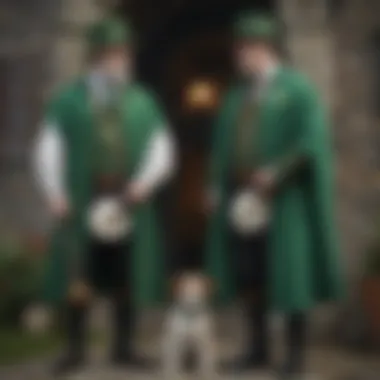The Legacy of St. Patrick: Understanding Irish Heritage


Intro
St. Patrick’s Day is more than just an annual celebration marked with parades and green attire; it’s a window into the heart of Irish culture and heritage. But, who was St. Patrick, and why do we honor him? This article embarks on a journey to illuminate the layers of significance that this day brings, from its historical roots to how people around the world celebrate it today.
Understanding the story of St. Patrick requires more than just a glance at history; it involves delving into the mingling of folklore, religion, and national identity. Whether you’ve enjoyed a pint of Guinness on March 17th or simply admired the cheerful displays of shamrocks, this exploration will unveil the values and beliefs embedded in the traditions that emerged from the life of a man who became a symbol of hope and resilience for the Irish people.
Prelims to St. Patrick
St. Patrick is more than just a name associated with a lively holiday; he embodies a rich tapestry of history, faith, and cultural identity that resonates profoundly within Irish heritage. This section lays the groundwork for understanding the reverence held for this figure, who, across centuries, has become a symbol of resilience and community for people of Irish descent worldwide.
Historical Background
Understanding the historical backdrop of St. Patrick’s life offers invaluable context to his enduring legacy. Born in Roman Britain in the late fourth century, Patrick was captured by Irish raiders and taken to Ireland as a slave at a young age. His initial captivity lasted six years but instilled in him a deep sense of spirituality. During this tumultuous time, he turned to prayer and faith as a means of comfort. This significant event not only shaped his future vocation but also set him on a path of remarkable transformation.
Once Patrick escaped and returned to his family, he felt a calling to return to Ireland not as a captive, but as a missionary. His mission aimed to convert the Irish to Christianity, challenging the pagan beliefs of the time. This commitment to spread his faith against considerable odds speaks volumes about his character, and offers a powerful narrative of redemption.
St. Patrick's Early Life
St. Patrick’s early life is a blend of hardship and enlightenment. Growing up in a relatively well-off family, he likely experienced a comfortable upbringing. However, his life took a drastic turn with his abduction. This transition, from a carefree boy to a slave in a foreign land, shaped Patrick in ways that would define his life's work.
During his captivity, he learned the language and customs of the Irish people, which would later prove essential in his ministry. Imagine being taken away from everything you know, having to adopt new ways and be resilient in the face of adversity. It's a story not dissimilar to what many face today; adapting, learning, and growing through challenges.
His return as a man of faith signifies a profound change, not only for Patrick himself but also for the countless lives he would touch in Ireland. It is this compelling early life story that anchors his legacy, providing a familiar connection for children and families exploring the rich traditions of Irish culture. It’s not just about tales of the past; it’s about lessons of courage, hope, and the relentless pursuit of one’s purpose.
Significance of St. Patrick's Day
St. Patrick's Day has grown from modest beginnings into a significant cultural celebration, not just in Ireland but across the world. It serves as a symbol of Irish heritage, unity, and the spirit of resilience that defines the Irish people. One of the main reasons St. Patrick's Day is so important is that it brings together individuals of all backgrounds to celebrate a shared appreciation for Irish culture.
Key Points of Significance
- Irish Identity: The holiday acts as a touchstone for Irish identity. It’s a day where people embrace traditions, music, and food, allowing them to reconnect with their roots.
- Cultural Exchange: St. Patrick's Day fosters a space for cultural exchange. Non-Irish individuals partake in the celebrations, learning about history, customs, and values.
- Community Engagement: The day encourages community gatherings, promoting inclusivity and friendship. Local parades and events create a sense of belonging.
Origins of the Holiday
The origins of St. Patrick's Day can be traced back to the 17th century when it was established as a feast day to honor St. Patrick, the patron saint of Ireland. Initially observed by the Catholic Church, this day fell on March 17th, marking the supposed date of St. Patrick's death in the year 461 AD. As the years trudged on, it picked up momentum not just as a religious day, but as a celebration of Irish culture.
In Ireland, people used to attend church services on St. Patrick's Day, but it was often about much more than religion. Traditional celebrations involved eating hearty meals, usually featuring dishes like lamb, potatoes, and cabbage. The day also evolved to highlight the connections people felt to the land and to their communities.
Cultural Impact


As the diaspora spread, so did the celebrations. Irish emigrants, particularly in the United States, took St. Patrick's Day with them, transforming it into a festive occasion filled with parades, green clothing, and public celebrations. These festivities often occurred prominently in cities like New York and Chicago, where large Irish-American populations settled.
Effects of the Cultural Impact
- Parades and Festivals: The image of vibrant parades featuring music, dance, and elaborate costumes is now synonymous with this day. The New York City parade is among the largest, showcasing Irish pride and strengthening community ties.
- Global Recognition: Countries worldwide, from Australia to Japan, now participate in St. Patrick's Day activities, highlighting the universal appeal of Irish culture.
- Promotion of Irish Tourism: The day draws tourists to Ireland, eager to experience the authenticity of the celebrations in their birthplace.
St. Patrick's Day gets people talking, sharing, and learning about the rich tapestry of Irish life and culture.
Symbols Associated with St. Patrick
Symbols play a crucial role in connecting people to their cultural roots. They serve as visual reminders of historical tales and beliefs that shape a community's identity. In the case of St. Patrick, several symbols stand out, compelling people to reflect on their heritage and the stories passed through generations. These symbols resonate deeply within Irish culture and beyond, enriching the overall narrative surrounding St. Patrick and his enduring legacy.
The Shamrock's Role
The shamrock is arguably the most recognized symbol linked to St. Patrick. Traditionally, this three-leaved plant is believed to have been used by St. Patrick himself while preaching Christianity to the Irish. According to legend, he illustrated the concept of the Holy Trinity—the Father, the Son, and the Holy Spirit—by holding up a shamrock. This clever teaching tool not only helped people understand complex ideas but also rooted Christianity in the Irish identity.
The shamrock's significance extends beyond the church, becoming emblematic of Irish pride, especially during celebrations like St. Patrick's Day. It’s common for people to don shamrock-themed clothing or accessories to showcase their connection to Ireland and honor St. Patrick. The green hue of the shamrock, often associated with nature and growth, embodies hope and renewal. Thus, it cements its place in the heart of those who celebrate,
"The shamrock is a little bit more than just a plant; it’s a symbol of identity and faith intertwining."
Snakes and Their Symbolism
In the tales surrounding St. Patrick, snakes carry a significant, albeit metaphorical, weight. According to folklore, St. Patrick is said to have driven all snakes out of Ireland during his mission to convert the Irish to Christianity. While it's widely accepted that snakes were never actually present in Ireland, this story symbolizes the triumph of good over evil and the eradication of pagan beliefs. The snake represents the old ways that St. Patrick sought to eliminate, transforming the land into a more spiritually enlightened place.
This symbolism transcends the tale itself, as snakes often appear in various cultures as figures of temptation or moral conflict. In this context, the story of St. Patrick stands as a powerful reminder of the importance of faith and moral clarity in the face of adversity. By expelling what snakes symbolize, St. Patrick is celebrated not just as a religious figure but as a cultural hero who sought to unify people under a common belief.
Color Green and Its Importance
The color green is a prominent feature during St. Patrick's Day celebrations, flecking everything from clothing to food. Historically, this color has deep roots in Irish history and culture. Green symbolizes the lush landscapes of Ireland, often referred to as the Emerald Isle. It evokes images of rolling hills and verdant fields, emblematic of the nation's natural beauty.
Additionally, green is tied to Irish nationalism and pride. Wearing green on St. Patrick's Day serves as a statement of identity, seamlessly linking people to their Irish heritage. Folklore attributes green's significance to folklore as well, suggesting that wearing it makes one invisible to leprechauns—mischievous little creatures that would pinch anyone they could see. Thus, wearing green is both a practical choice and a statement of cultural allegiance.
In summary, the symbols associated with St. Patrick—shamrocks, snakes, and the color green—yield layers of meaning that elevate the cultural significance of St. Patrick’s legacy. These elements form an intricate web of historical references and societal values, giving depth to celebrations and enriching the Irish heritage.
Festivities and Traditions
When we think about St. Patrick, it's hard not to visualize the vibrant celebrations that follow. The festivities and traditions surrounding St. Patrick’s Day are rich in cultural significance. They help connect the past to the present, showcasing the values and beliefs of the Irish people. These customs not only honor St. Patrick but also serve as a way for communities to come together, celebrating their shared heritage.
Traditional Irish Music and Dance


Music and dance are at the heart of Irish culture, serving as powerful ways to express joy and unity. Traditional Irish music often features instruments like the fiddle, bodhrán, and tin whistle. It's lively and engaging, inviting everyone to join in the fun.
As for dance, the famous Irish jig is an exciting tradition that many families and groups participate in. It isn’t just about movement; it’s about storytelling through rhythm and steps. You will often find people gathering around, sharing tunes and engaging in lively dances during festive celebrations. This lively interaction echoes the spirit of community, as each note brings people closer together.
"Music has a way of making memories stick. It's a bridge between generations, a reminder of where we come from."
Feasting and Traditional Foods
Another beautiful aspect of St. Patrick’s Day is the food. Traditional Irish fare often includes dishes like corned beef and cabbage, shepherd’s pie, and soda bread. Feasting is about more than just eating; it represents hospitality and sharing.
Families often gather around tables, serving dishes that not only nourish the body but also strengthen the bond between loved ones. One special treat often enjoyed is the rich, sweet taste of Irish soda bread, which is easy to make and share. These meals aren't just about sustaining hunger; they are steeped in history and reflect the seasonal rhythms of Irish life.
Parades Around the World
Perhaps the most thrilling aspect of St. Patrick’s Day is the parades. From Dublin to New York City, these events are grand showcases of Irish culture. Brightly decorated floats, lively music, and a sea of green attire transform city streets into a lively tapestry of celebrations.
In places like Chicago, the tradition goes a step further, as the river is dyed green to add to the festive cheer. These parades draw enormous crowds, emphasizing that the spirit of St. Patrick transcends boundaries. It’s not just about one nationality celebrating; it’s about everyone partaking in the excitement, regardless of background. People cheer, dance, and carry signs, creating an atmosphere of inclusion and joy.
In summary, the festivities and traditions surrounding St. Patrick’s Day allow people to connect with their roots and celebrate their identity. Through music, food, and parades, the spirit of St. Patrick continues to thrive, uniting individuals across the globe in a joyous commemoration of heritage.
Modern Interpretations
Understanding modern interpretations of St. Patrick’s legacy is crucial in grasping how his influence has permeated various aspects of contemporary life. This heading serves as a bridge between the historical significance of St. Patrick and the ways his story and traditions continue to evolve in today’s society. The celebration of St. Patrick’s Day has taken on numerous forms, emphasizing values like community, cultural identity, and resilience.
St. Patrick's Day in the U.S.
In the United States, St. Patrick's Day has blossomed into one of the most significant cultural celebrations. Initially acknowledged in regions with large Irish populations, such as Boston and New York, the day has transformed into a nationwide festivity. The importance of this celebration goes beyond parades and the wearing of green; it embodies an opportunity for people of all backgrounds to pay homage to Irish heritage.
- Festivities and Events: Parades, bar crawls, and festivals now attract millions, showcasing Irish culture through music, dance, and traditional foods. Not just the Irish, but many Americans engage actively in the festivities, creating a multicultural atmosphere.
- Symbolic Foods: Corned beef and cabbage have become staples on this day, reflecting how Irish immigrants adapted tradition to fit what was available in their new homeland. This theme of adaptation highlights the resilience and ingenuity of the Irish-American community.
The blending of traditions seen in the States illustrates how cultural customs can evolve while keeping their essence intact. Communities come together, celebrating with pride, and the day fosters a sense of belonging, even for those without Irish ancestry.
Global Celebrations
Celebrations of St. Patrick's Day have crossed borders, with places like Tokyo, Sydney, and Buenos Aires joining in the revelry. While the essence of the celebration remains, each location adds its flair, creating unique experiences.
- Diverse Traditions: In places like Japan, for instance, a green beer often steals the spotlight, but local customs and festivities blend into the celebrations, showcasing the host country's culture alongside Irish traditions. Add to that the sites like the Sydney Opera House lit up in green, it emphasizes that St. Patrick's legacy has become a global phenomenon.
- Unifying Impact: These worldwide festivals foster connections between diverse communities, creating opportunities for shared experiences and understanding across cultures.
The broader celebration of St. Patrick’s Day affirms that cultural heritage can be a unifying force, promoting appreciation, friendship, and respect among different peoples.


In essence, the modern interpretations of St. Patrick and his story show how his legacy has become a platform for celebrating not just Irish culture, but a tapestry of global connections that's continuously being woven together with every passing year.
Lessons from St. Patrick's Story
St. Patrick's story is not just about his acts and adventures; it’s a compelling lesson in resilience, faith, and cultural identity. For young readers and those curious minds, the lessons extracted from the life of St. Patrick can be quite enlightening. The very essence of his journey illustrates that even amidst overwhelming odds, one can persevere and remain steadfast in their beliefs.
Themes of Resilience and Faith
In the tale of St. Patrick, one finds a striking narrative about resilience. Captured and enslaved in a foreign land at a young age, Patrick did not let despair dictate his life. Instead, he turned to his faith, which became his anchor during those turbulent times. It's remarkable how his belief not only sustained him but also guided him towards eventual freedom.
For children aged five to twelve, this aspect of his story could be a wake-up call. It teaches that even when life feels difficult—like when homework seems too hard or when friendships are complicated—it's essential to hold onto hope. Resilience is the ability to bounce back, whether it’s after a tough day at school or tackling a personal challenge. Here are some important takeaway points:
- Never Give Up: St. Patrick’s journey shows perseverance in the face of adversity. Kids can learn that trying again is part of growing up.
- Faith as a Strength: Whether one considers faith in a personal belief system or confidence in one’s abilities, this strength can help overcome obstacles.
- Learning from Trials: Every setback is a lesson. St. Patrick’s life emphasizes that challenges can lead to greater wisdom and personal growth.
"Resilience is not about avoiding failure but understanding how to rise from it."
Cultural Identity and Pride
Cultural identity is a significant theme in St. Patrick’s life. His story enables us to grasp the importance of knowing where we come from, celebrating our roots, and feeling proud of it. As he spread the message of Christianity, he also embraced Irish culture, connecting many people to their heritage.
For young readers and families, recognizing cultural identity ignites a sense of pride. Here are some insights:
- Understanding Background: Children can begin to appreciate their own heritage and the diversity surrounding them.
- Celebrating Differences: Encouraging acceptance and admiration of various cultures aligns with learning about St. Patrick’s embrace of Irish traditions.
- Building Connections: Awareness of one’s identity can foster community spirit and form connections with others, essential for building lasting relationships.
Instilling pride in heritage helps children develop a positive self-image while respecting others. It’s about understanding that, like St. Patrick, all cultures have something special to offer.
His story is indeed a framework by which children and families can navigate personal growth and cultural appreciation.
The End
The legacy of St. Patrick transcends mere historical recounting; it infuses the spirit of Irish culture and identity with profound meaning. As we reflect on St. Patrick's contributions and the festivities that take center stage each March, we uncover layers of resilience, unity, and pride woven into the fabric of Irish heritage. This article invites you to recognize not just the celebratory aspects of St. Patrick’s Day but also the deeper connections to family, community, and cultural continuity.
Reflection on St. Patrick's Legacy
St. Patrick stands as a beacon in the narrative of Ireland, representing more than just the man who brought Christianity to a land steeped in pagan traditions. His story is one of overcoming adversity; captured as a slave in his youth, he escaped and returned to guide his people. This resilience and ability to navigate the challenges of life are not just historical footnotes—they echo throughout generations, reminding us that perseverance can lead to remarkable outcomes, both for individuals and communities.
"His legacy isn’t just about snakes and shamrocks; it narrates a journey that resonates deeply within human experiences, displaying how faith can nurture hope and transformation."
Reflecting on St. Patrick's legacy, we see how it inspires people to strive for betterment while embracing their cultural roots. His influence encourages everyone, especially the younger generations, to explore what it means to be proud of their identity and history.
Embracing Cultural Heritage
Embracing our cultural heritage, like that of St. Patrick, is about standing in unity while celebrating diversity. The traditions stemming from St. Patrick’s Day, such as wearing green, parading through town, and partaking in traditional foods, forge connections among people. They remind us of the importance of preserving our roots while welcoming others into our communities.
Irish heritage is now viewed as a tapestry woven from countless threads—each representing various stories, experiences, and customs. When families celebrate St. Patrick's Day, they participate in acts that preserve these stories, ensuring they’re passed to the next generation. Teaching children about such important figures and traditions cultivates respect and curiosity about different cultures.
Thus, as we embrace our heritage, we also open ourselves to learn from others—bridging gaps, sharing stories, and creating a world rich in collaboration and understanding. Celebrating St. Patrick, therefore, becomes a celebration not only of Irish culture but of being a part of this vast human experience.







